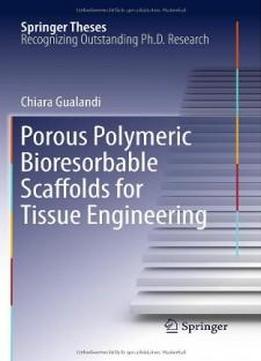
Porous Polymeric Bioresorbable Scaffolds For Tissue Engineering (springer Theses)
by Chiara Gualandi /
2011 / English / PDF
5.2 MB Download
The development and application of bioactive nano-structured constructs for tissue regeneration is the focus of the research summarised in this thesis. Moreover, a particular focus is the rational use of supercritical carbon dioxide foaming and electrospinning technologies which can lead to innovative polymeric bioresorbable scaffolds made of hydrolysable (both commercial and ‘ad-hoc’ synthesized) polyesters. Mainly, the author discusses the manipulation of polymer chemical structure and composition to tune scaffold physical properties, and optimization of scaffold 3D architecture by a smart use of both fabrication techniques. The multidisciplinary nature of this research is imperative in pursuing the challenge of tissue regeneration successfully. One of the strengths of this thesis is the integration of knowledge from chemistry, physics, engineering, materials science and biomedical science which has contributed to setting up new national and international collaborations, while strengthening existing ones.
The development and application of bioactive nano-structured constructs for tissue regeneration is the focus of the research summarised in this thesis. Moreover, a particular focus is the rational use of supercritical carbon dioxide foaming and electrospinning technologies which can lead to innovative polymeric bioresorbable scaffolds made of hydrolysable (both commercial and ‘ad-hoc’ synthesized) polyesters. Mainly, the author discusses the manipulation of polymer chemical structure and composition to tune scaffold physical properties, and optimization of scaffold 3D architecture by a smart use of both fabrication techniques. The multidisciplinary nature of this research is imperative in pursuing the challenge of tissue regeneration successfully. One of the strengths of this thesis is the integration of knowledge from chemistry, physics, engineering, materials science and biomedical science which has contributed to setting up new national and international collaborations, while strengthening existing ones.











